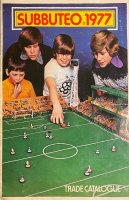
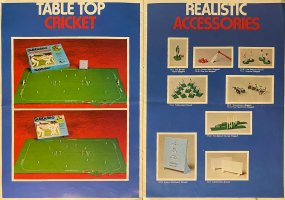
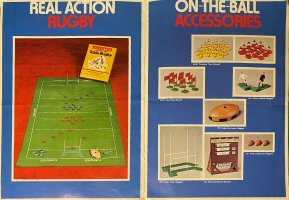
| Peter Upton's |
|
Subbuteo Tribute Website. |
|
Miscellaneous Items |
|
Non Retail - Trade Catalogues, Items and Stationery. |
This page features some quirky little items that have surfaced in the Subbuteo Collecting Community. Whilst Peter Adolph did originally sell directly to his players, the later Subbuteo Sports Games Limited company had a more important set of customers, and that was the trade buyers. This was toy shops, department stores, and above all independent Sports Shops. This page is mostly concerned with items produced for them.
The first section deals with the trade catalogues in more detail, allowing me to illustrate them properly, and add a 1977 version previously unseen on this website.
The rest of this page is essentially the mundane. The envelopes, the headed notepaper, invoices and complement slips. All the things a company needs simply to trade. These were never meant to be sold or circulated in this way, and I imagine that the old Subbuteo employees would be astonished to find that these items even survived, let along found their way into collections. If Peter Adolph had chosen an unrelated name for his trading company rather than Subbuteo Sports Games Limited, or if Waddingtons had bought the game fully under their company umbrella, then I imagine this section would have no real reason to exist. As it is, it is rather charming to see the famous little football logos appearing on stationery, and general ephemera.
Of course, the most important thing to be produced for the Trade were the Shop Displays both the early team colour displays and the later racks designed to show off the company's wares. These have long been sought after, and are already covered on their own page.
Trade Catalogues.
The 1977 Trade Catalogue.



Trade catalogues were produced for the company's reps, and to allow stockists and potential stockists to review the range, and decide what products they might want to carry. The 1980s versions also had pictures of display stands that could be acquired that would show off the stock to maximum potential.
Obviously Trade catalogues have a limited release, and it is hard to know for which years were produced. This one from 1977 is the earliest one that I've seen. It contains full details of Subbuteo's sports game range of the time. The pictures are pretty comprehensive, with the cricket and rugby sets fully laid out, and good details of the associated accessory ranges.
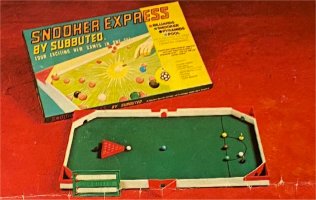
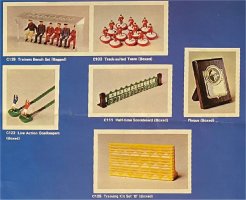
There are similar pictures for Football Express, and Snooker (which actually makes this rare Subbuteo Dud look appealing). Talking of duds, the most surprising page in this catalogue is the one showing a range of old, and soon to be deleted stock. As shown above, the track-suited team, the goalkeeper's rebound wall, the half-time scoreboard and award plaque were all chosen to be illustrated. Were they trying heroically to clear the stock?
The 1982 Trade Catalogue.
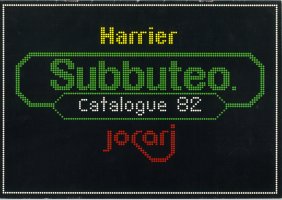
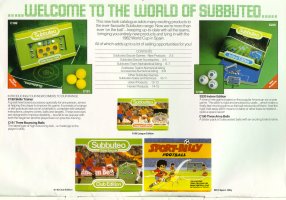
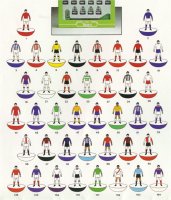
The early 1980s trade catalogues are probably familiar, as they have already featured elsewhere on this site They were generally shared with other products such as Jokari's ball games, or Dunford kites. The Jokari Products page covers these things in more detail. Unlike the retail catalogues of the late 1980s, these trade catalogues were designed in a landscape format.
From a collectors point of view perhaps the most interesting thing about these catalogues is the reduced team range. It is explained that the company had realised that the full team range of the time was unwieldy for shop owners. So they provided an illustrated list of the top selling teams (clearly specific to the UK), so it was easier for stores to order what they required. This list was 100 teams in the 1982 and 1983 catalogues, but cut to 75 teams by 1985.
The new products shown in 1982 included the Indoor Edition, the C189 Skills Trainer, and the high-bounce balls.
I have details of most, if not all of the reduced team lists, and will probably add them as an appendix to the team charts when I get a bit of time.
Some of the details are already on site though - I did highlight the teams included in 1982 in my team lists.
The 1983 Trade Catalogue.
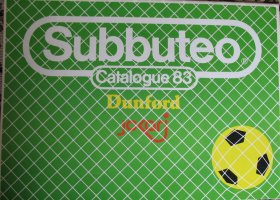
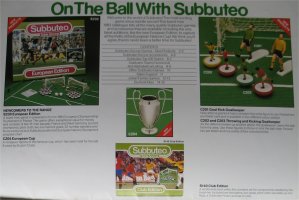
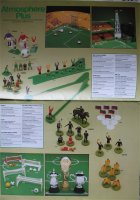
The 1983 catalogue has Jokari products and Dunford Kites. New items in the Subbuteo range were the European Edition, the European Cup, and the extra spare goalkeepers - the kicking and throwing 'keepers being some of the last new moulds of the classic period. The final picture above shows a lovely double spread of accessories, and demonstrates how these catalogues were laid out. There was an updated top 100 team list too.
The 1984 Trade Catalogue.

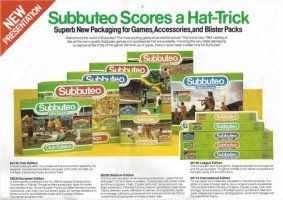
1984 saw less new items, so instead there are new presentations, as the attractive green logo boxes arrived. This is the last catalogue to have such a large range of sets, which surprisingly still included the Indoor Edition.
The 1985 Trade Catalogue.
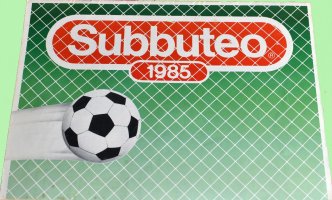

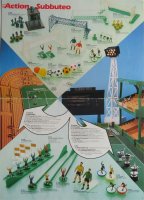

The 1985 trade catalogue is the last one from this era that I am aware of. As the retail range returned to catalogue form in 1986, it is probable that trade catalogues was dropped at the same time. I'd love to be wrong though. The internal pictures shown this time include a lovely one of the new style accessory boxes, plus another pair of full spreads showing the accessories clearly laid out, and the reduced "75 top teams" range. Interestingly, the full team range was also illustrated elsewhere in this catalogue.
Once again, there was a lack of new items, with the "new presentation" advertised for the Astropitch (a tube) being about as exciting as it gets. The huge ranges of yesteryear are slowly winding down by this time.
The 1995 Catalogue.
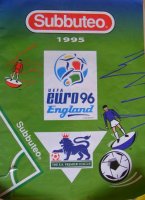
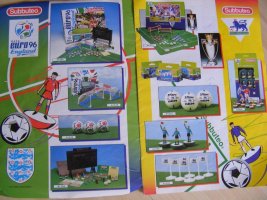
The retail catalogues returned to poster format in 1992, and so this extra catalogue for 1995 advertising the Euro '96 and Premier League ranges has always been a bit of a puzzle. Both the new licensed ranges are shown in a "pre-production" state, and the final releases did not resemble either the products or the boxes shown here. It is not actually called a trade catalogue, but if it had been released at retail, I'd assume it would be a much more common item than it is (I've only ever seen this one version). I assume it was produced to show retailers what exciting new products were coming to a revamped Subbuteo range. Details of the aborted accessory ranges shown in this catalogue have long been shown on my accessory lists of course, but the catalogue hasn't been shown until now.
The Wall Planner.
Score with Subbuteo - all the year round.
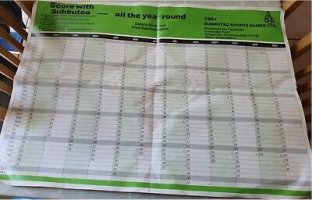
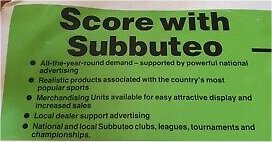
Like most of the items shown below, you'll wonder how this little gem managed to survive. It is a simple promotional wall-planner for 1981. When I worked in newspaper wholesale it was one of those items that you knew your suppliers would provide without fail. I've included a close-up of the text at the top of the chart, so you can (hopefully) read the promotional help that SSG were offering to their retailers at this time.
Television Advert Promotional leaflet.
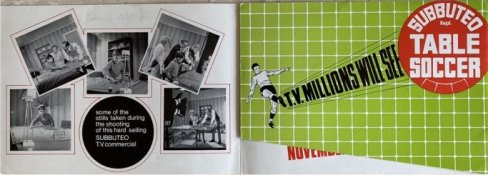
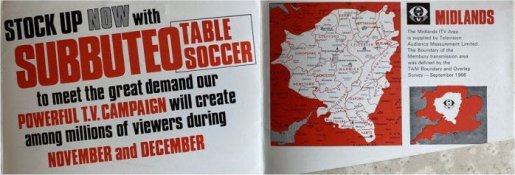
Again, a big thank you to Ashley Hemming who found these pictures online (and again, if they are yours, please let me know for a credit!). This leaflet was sent to stockists in the Midlands region advising of Subbuteo's pre-Christmas television campaign, and suggesting that they take advantage of any surge in interest. The advert was due to be shown in the ATV Midlands area of ITV, at a time when independent TV was much more regional than it is now. The map and details of the ATV region are dated to September 1966, and this suggests that Subbuteo as a company were feeling very confident post England's win at the 1966 World Cup.
Subbuteo's television advert of the mid-1960s still exists, and is probably online somewhere if you want to search for it.
List of Stockists (Area No. 9)
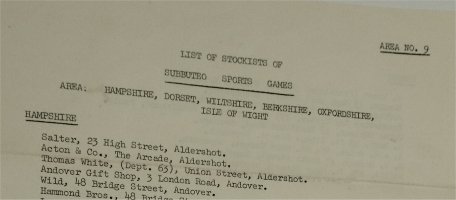
Regular contributor Ashley Hemming is rightly proud of this one. Until the introduction of the OO scale sets in 1961, the Subbuteo catalogues had advised that product was available direct from Peter Adolph "manufacturer and distributor". However, with the OO scale era, retail shops became increasingly important. If you sent for "details of your local stockist" this typed list of shops was the response. As you can probably see, this list of the mid-southern counties was Area No.9. There were a lot of stockists listed, with the vast majority being independent Sports Shops. There were also a fair few department stores, plus some Co-ops, gift shops, and a few toy shops. Not so many toy shops though, which shows the market that Peter Adolph was aiming for. By my own era of the late 1970s/early 1980s, this seemed to change, with the toy shops being the biggest stockists.
Ashley also owns the list of stockists for "Area 4" which covered the south midlands, and East Anglia. He's more nostalgic about that one, as he had actually visited some of the Oxford and Buckinghamshire shops as a lad. That second list starts with the following disclaimer
"This list cannot be complete as new Retail accounts for SUBBUTEO Sports Games are being opened daily. We do, therefore, request Customers to be so good as to ask at their usual local Retailer (store, Sports Games, Toys, etc) for our games before going elsewhere. Thank you." Yes, you can do Subbuteo's marketing for them!
The envelope is shown further down the page. This looks like somebody tore off the stamp (honestly, collectors eh?), so the important dated part of the postmark is missing. So we don't have an accurate date for this list sadly.
Invoices.
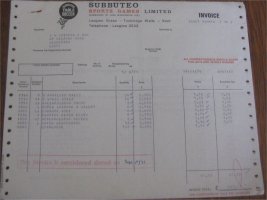
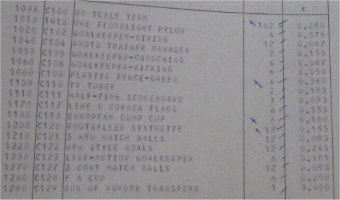
Here is the joy of dot-matrix printer paper, with the little holes... Honestly, I'm getting nostalgic about all the rubbish old jobs I used to do. Blimey, did that printer chew up paper on a regular basis.
This is a lovely Subbuteo invoice produced for a store called JA Withers & Son in Leicester in August 1971. It lists accessories in both the continental range and the older lettered range, although those were mostly items that were soon to move across such as balls, the pitch, and the scoreboard.
The shop owner ordered 162 teams at 28p each, but sadly there isn't a breakdown of references. That would have been useful even if it just emphasised the sales gulf between the popular teams, and the minor ones. The shop also ordered a large array of accessories, and the popular items are clearly those that need replacing most often - balls and goalkeepers. They ordered far less of items like the photographers and the TV tower. The biggest sellers were sets F and FF, which were the original large and small sized balls. 24 packs of each were ordered here.
The teams were charged at 28p to the trade, and the retail price was 52.5p
A single Floodlight pylon was 37.5p at trade, and retail of 70p. You can follow the list down if you need more of this, but you get the general percentage given to retail.
Letters and Letter headed paper.
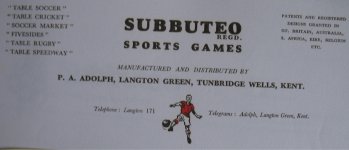
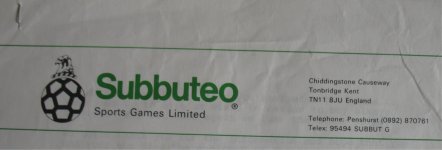
Here is the letter head for two different eras of Subbuteo. The one on the left is from a letter dated September 1960. This was Peter Adolph's era, and the heading lists the games of the time including Speedway. The typed letter was to the Bradford Table Soccer League asking for a misplaced league table so it could be added to the Bulletin. It also asked if players would be available for the "Silver Cup" competition. It was therefore written by George Underwood rather than Peter Adolph himself.
The second letterhead is from the Falcon crest era, and is dated to July 1981. I have mentioned this letter elsewhere on site. It was a detailed response to a letter asking whether the old flats were still available (they weren't), and querying the accuracy of Subbuteo's team colours (it is explained why this is a problem for the company). The letter was signed by John Burbridge, who was a director throughout the 1970s. His signature replaces Peter Adolph's in the advanced rule book when Adolph left the company. I had an email from him many years ago, where he explained that this was the most fun job he ever had. I don't doubt it.
Subbuteo are using the Chiddingstone Causeway address for all correspondence at this time.
The text at the bottom of the letter gives the Chairman as J Scott, the Managing Director as JW Leng, and Directors of CJL Bowes, JT Burbridge, DJ Morrison-Wilpred, and CT Rankin. The Secretary was BT Tasker. Morrison-Wilpred had been with the company since Peter Adolph's era, and was interviewed about his roles by the early collectors.
The Complement Slips.
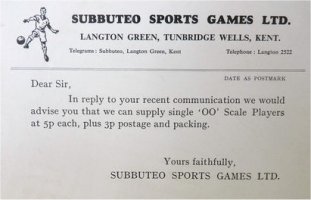
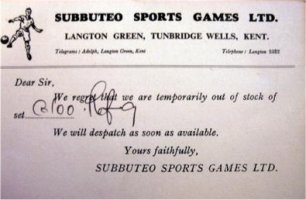
You didn't always get a full letter from the firm. For simple queries, a small complement slip was deemed sufficient. These two look like standard responses. It is interesting that you could buy/request single players for a small fee. If that was more widely known, it might have saved a lot of bad gluing attempts. The second slip shows a stock shortage on a surprisingly common reference number. Sadly neither slip is dated, although the single player version is from the decimal era (post 1971) even though the logo looks older.
Envelopes.
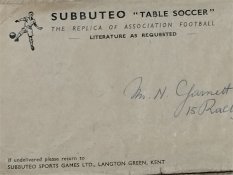
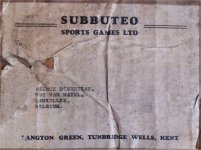
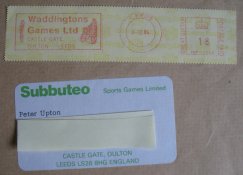
The first picture shows the details from a standard business envelope from the 1960s. This was the envelope that included the list of Stockists shown further up the page. Then there is a nice printed box label from the early 1970s. The third picture is details from an A5 envelope that passed through the Waddingtons Games Ltd franking machine on 3rd December 1984. At this point, Subbuteo had moved to the Waddingtons headquarters at Castle Gate, Oulton, Leeds. It's still a Subbuteo Sports Games Limited address label though.
The name on this one might be familiar (and that's why I've knocked the address off), so I know that this envelope contained a brief letter explaining how to order direct from Subbuteo, plus the current price list, and a catalogue/poster (1984 I'm assuming). I had written to Subbuteo because I had been unable to obtain an Astropitch locally. I'm pretty sure I did get one for Christmas that year, but whether my folks ordered direct, or found it locally I don't know. The letter is long lost, and the poster is tatty and covered in blue-tac, but this envelope somehow survived.
Envelopes. I know, how exciting is this page? If you don't need a lie down to recover, you can pick another destination.